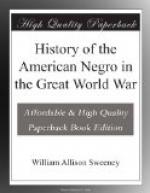Sergt. Norman Henry, 5127 Dearborn St., Chicago, attached to the 3d Machine Gun Company, 370th Infantry, won the Croix de Guerre and Distinguished Service Cross. It was in the Soissons sector September 30 in the first rush on the Hindenburg line.
All of the officers and men fell under a heavy machine gun barrage except two squads of which Sergeant Henry was left in command. They took two German dugouts and were cut off from their own line without food. They held the Germans off with one machine gun for three days. Often the gun became jammed, but they would take it apart and fix it before the enemy could get to them.
Lieut. Samuel S. Gordon, 3934 Indiana Avenue, Chicago, of the 370th Infantry, exposed himself to open machine gun fire for six hours and effected the rescue of two platoons which had been cut off by the barrage.
Company H had been badly cut up in a sudden burst of machine gun fire. Lieutenant Gordon with some men were rushed up to relieve what was left of the company, and while reconnoitering were cut off by the same fire. A stream of water four feet deep lay between them and their trenches. By standing in the stream, Lieutenant Gordon let the men crawl to the edge of the bank, where he lifted them across without their having to stand up and become targets.
Corporal Emile Laurent, 5302 So. Dearborn Street, Chicago, a member of the 370th Infantry, had a busy time dodging machine gun bullets one night near Soissons. Volunteering as a wire cutter, he crawled out with his lieutenant’s automatic in one hand and the wire clippers in the other. Half a dozen machine guns were opened upon him as he sneaked along the terrain. “Never touched me,” he would yell every time a chunk of steel parted his hair. He was out for three hours and cut a broad line through the charged wire. Then he crawled back without a mark on him.
Private Leroy Davis of the same regiment, won a decoration at the Aillette Canal for bringing a comrade back under machine gun fire. When he got back to his own lines he would not trust him with the ambulance outfit, but carried him three miles to the emergency dressing station and then he ran back to the canal to get even. This little stunt saved his comrade’s life.
Praise for the American soldier comes from Charles M. Schwab, the eminent steel manufacturer, who was chosen by President Wilson to head the Emergency Fleet Cororation, and rendered such conspicuous service in that position. Returning in February, 1919, from a trip to Europe, Mr. Schwab said in an interview:
“I have come back with ten times the good opinion I had of our soldiers for the work they did. Everywhere I went I found that the American soldiers had left a good impression behind and there was nothing but the greatest praise for them.
“During the present voyage I have been among the colored troops on board and talked with them and learned what American soldiering has done for them. They are better men than they were when they went away.”




